Related Research Articles

The Bagmati River flows through the Kathmandu valley of Nepal, separating the cities of Kathmandu and Patan, before flowing through Madesh Province of southern Nepal and joining the Kamla River in the Indian state of Bihar. It is considered holy by both Hindus and Buddhists. A number of Hindu temples are located on its banks.
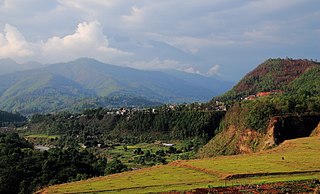
Nuwakot District (Nepali: नुवाकोट जिल्ला, a part of Bagmati Province, is one of the seventy-seven districts of Nepal. The district, with Bidur as its district headquarters, covers an area of 1,121 km2 and had a population of 288,478 in 2001 and 277,471 in 2011. It is a historically important district in Nepal. Prithvi Narayan Shah died in Devighat of Nuwakot.

Haridwar district also spelled as Hardwar is a district in Garhwal which is a part of Uttarakhand, India. It is headquartered at Haridwar which is also its largest city. The district is ringed by the districts Dehradun in the north and east, Pauri Garhwal in the east and the Uttar Pradesh districts of Muzaffarnagar and Bijnor in the south and Saharanpur in the west.
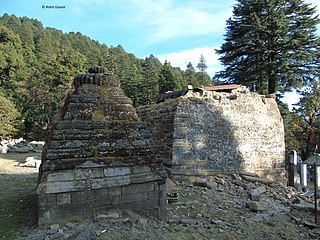
Pauri Garhwal is a district in the Indian state of Uttarakhand. Its headquarters is in the town of Pauri. It is sometimes referred to simply as Garhwal district, though it should not be confused with the larger Garhwal region of which it is only a part of.

Kanore is a town in Udaipur district in the Indian state of Rajasthan.

Panauti is a municipality in Kavrepalanchok District in Bagmati Province of Nepal located 32 km Southeast of the capital Kathmandu. The town is currently listed as a UNESCO tentative site since 1996.

In Hinduism, the yatra (pilgrimage) to the tirthas has special significance for earning the punya needed to attain the moksha (salvation) by performing the darśana, the parikrama (circumambulation), the yajna, the Dhyana, the puja (worship), the prarthana, the dakshina, the seva, the bhandara, etc. These sacred places are usually located on the banks of sacred waters, such as sacred rivers or their tributaries, the kundas, the ghats, or the stepwells, or the temple tanks.

Rajim Kumbh is an annual Hindu pilgrimage held in Rajim, located in Gariyaband district, Chhattisgarh, India. The pilgrimage is similar to the traditional pilgrim fairs like those held in Haridwar and Allahabad. Like them, it's a kumbh, where devotees flock in to bathe en masse in sacred rivers to wash off their sins and attain redemption.
The culture of Gujarat is both ancient, new, and modern.
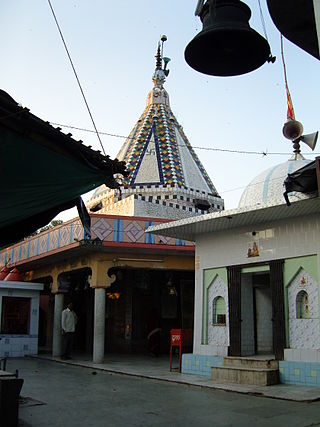
Gola Gokaran Nath Temple is a Hindu temple in Gola Gokarannath, Uttar Pradesh, India, and is also known as Shiva temple of Gola Gokaran Nath. It is a temple dedicated to Lord Shiva. The Gola Gokaran Nath is also called Choti Kashi.
Kunnur is a village in the southern state of Karnataka, India. It is located in the Chikodi taluk of Belgaum district in Karnataka.

Har Ki Pauri, meaning the feet of Lord Vishnu (Hari), is a ghat on the banks of the river Ganga and landmark of the Hindu holy city of Haridwar in the Indian state of Uttarakhand.

Parshuram Mahadev Temple is a cave Shiva temple located at border of Pali district and Rajsamand district of Rajasthan state in India. The main cave temple comes in Rajsamand district, whereas Kund Dham comes in Desuri Tehsil of Pali district. It is about 100 km away from Pali and only 10 km from famous Kumbhalgarh fort. The place is 14 km from Sadri town and 160km from Jodhpur. Access from lower altitude Sadri side is easier; however, access from Kumbhalgarh, Rajsamand, Nathdwara or Udaipur involves a little trekking downhill from a place designated as parking for the temple. There are 500 stairs to reach the ancient cave from Sadri side.

The Ambubachi Mela is an annual Hindu mela (gathering) held at Kamakhya Temple in Guwahati, Assam. This yearly mela is celebrated during the monsoon season that happens to fall during the Assamese month Ahaar, around the middle of June when sun transit to the zodiac of Mithuna, when the Brahmaputra river is in spate. During this time Brahmaputra River near the temple turns Red for three days.

Shree Moteshwar Mahadev, also known as Shree Bheem Shankar Mahadev, is an abode of Lord Shiva in Kashipur of Uttarakhand state, India. This place was known as the Dakini State in ancient days.
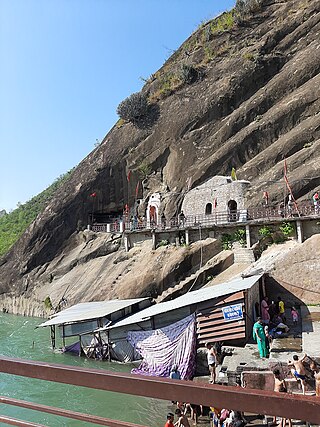
Mukteshwar Mahadev Temple, also known as Mukesaran Mandir, is a shrine to Shiva and man-made cave complex located near Pathankot City, Punjab, India. on Shahpur Kandi Dam road. It is a Hindu temple containing representations of Ganesha, Brahma, Vishnu, Hanuman, and Parvati. It is considered to be one of the most sacred places around Pathankot. According to legend, the Pandavas stayed in the caves for a night during their exile (Agayatwas), and it is said that some of the caves date to the time of the Mahabharata.
Uttarakhand is a state in the northern part of India. It is often referred to as the "Devbhumi" due to its religious significance and numerous Hindu temples and pilgrimage sites found throughout the state. As a result, religious tourism forms a major portion of the tourism in the state. Uttarakhand is known for the natural environment of the Himalayas. 2019 Tourist Arrivals Domestic – 40,000,000 per/year and Foreigner – 150,000 per year. Tourism business in Uttarakhand generated ₹ 23,000 crores during 2013–14.

The Kumbheshwar temple complex is one of the oldest and busiest religious place of the old Patan town lying on its northern part. The major deities whose temple or shrine lies within the complex includes Kumbheshwor Mahadev, Bangalamukhi, Unmanta Bhairava, Gaurikunda, Harati, Manakamana, Kedarnath, Badrinath. The complex houses a natural spring which fills the adjoining ponds, the source of which is said to be Gosaikunda Lake in Rasuwa District. It is therefore believed that taking a dip in the pond during the festival of Janai Purnima is equivalent to doing the same in Gosainkunda.

Dungeshwor Temple is one of religious affairs in Dailekh district in Karnali Province. This place is located in Lower Dungeshwor, the highest place in Dailekh district. This places is located in the confluence of Loohre and Karnali river, at the level of 544 meters from the sea level. In ancient times, here is believed to be the end of the day. There are two temples by Shideshwor Mahadev and Dungal Temple in Dungeshwor. According to Ancient holy flame myth and Vaishwankar myth of Dailakh district, this area is considered to be a place in the center of five famous Panchkoshi, five in Dailekh district. Because of these diverse reasons it is considered to be a mantle. This bridge is currently located in the village of Naule Katuwal connected to Dullu Municipality. This campusphere is located near the Karnali highway in Karnali river and Larkakhola's turbulence. Interesting historical context has been popular about the predecessor of this loop. Dailekh has two places named Lower Dhungeshwor and Upper Dhungeshwor.
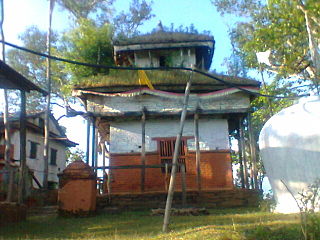
Dhuleshwor is a religious site in Dailekh District in Karnali Province, Nepal. It is one of five places under the Panchkoshi, the five holy places of Dailekh. This site is located at Badalamji village of Dullu Municipality.
References
- ↑ Rimal, रिमाल, & Bhawani, भवानी. (2021). काकेश्वरी मन्दिर क्षेत्रका साँस्कृतिक सम्पदा {Cultural Heritage of Kakeshwari Temple Area} [Thesis, नेपाली इतिहास, संस्कृति तथा पुरातत्व विभाग], pp 48. https://elibrary.tucl.edu.np/handle/123456789/11396